
Mishap
by Peter Burke
- View Peter Burke's Biography
Peter Burke is an artist and lecturer situated in Melbourne.
Mishap
Peter Burke
Imagine walking along a busy city street. A man ahead of you carries a briefcase. He trips on the footpath, the briefcase falls open and papers burst onto the ground. The man begins gathering the papers back into the case. A gust of wind sweeps some of them up into the air and one lands at your feet. What do you do? Pick it up? Leave it there? Pretend not to notice? Wait to see what others do? A passerby rushes to help and places a handful of papers back in the case. The man then snaps the briefcase shut and heads down the street.
Unknown to onlookers, the briefcase spill is deliberate. The man is a performer repeating the action on a loop--he releases his papers on every street corner to see how passersby will react. The artwork, entitled Mishap (2013-), is an ongoing participatory project created initially for the cities of Shanghai (2013) and Tokyo (2014). More recent iterations of the work have been produced in New Delhi (2015) and Bloemfontein, South Africa (2017). Bustling city locations were selected for their high pedestrian volume and commercial backdrops, and to provide a contrast to the small human gesture.
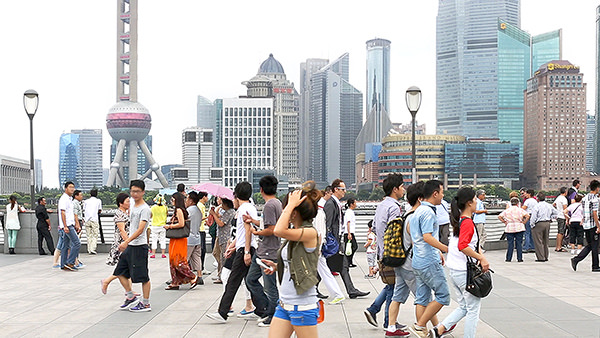
Mishap (Shanghai 2013), video still: Michael Rees-Lightfoot and Jasmine Blom
Mishap continues my ongoing exploration of performative interventions that gently shift or disrupt routine activity in social space. Using a fictional 'mishap', the work seeks to highlight social relations in regulated, commercial precincts and provide an understanding of variations in human behaviour in public space. Essentially there are two audiences for the work--a live audience in the street that is unprepared for the impromptu encounter, and an art audience in a gallery that views video documentation of the performance. In making the live work I sought to question how meaningful interaction can be created when a temporary artwork is shaped by the tensions of transience. The video work presented in 'Cancelled' (Eastern Bloc, Montreal, July 2017) features edited footage of the project from Shanghai and Tokyo and allows for more reflective responses.
From the 1960s onwards the site of art has come to be understood not only as a physical space but also one composed through social, economic, and political processes (Kwon 2004). In the contemporary shift from studio to sites and situations, a concern for temporality and site-specificity has evolved out of relational art practices (Doherty 2004). Artistic collaborations with sites can therefore be social. They can be unfixed enquiries defined by essentially unrepeatable, discursive, fleeting situations. They may include ethnographic processes, social relations, power relations, ethical considerations and conversations. As site and the social become more central to art practices and as artists engage with real life situations, the artist cannot avoid the existing relations within social spaces. Relations between sites of the art world and commerce are increasingly blended. While socially engaged art has become populist, readily absorbed into festivals, biennale culture and entertainment, activist art is equally neutralised by the conditions of power (Thompson 2012). Despite this, the aesthetic and political can occur simultaneously (Mouffe 2005; Rancière 2011). By performing poetic gestures the artist can temporarily unsettle patterns in social space.
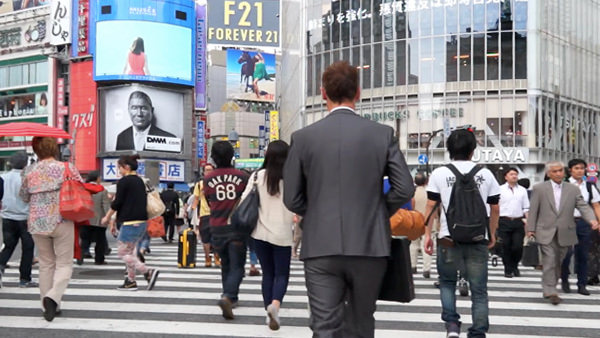
Mishap (Tokyo 2014), video still: Saeko Ehara
Historically the intersections between art and daily life have been key to many artists' practices including Allan Kaprow, Mierle Laderman Ukeles, Jiří Kovanda and Chim↑pom. One of the many groups engaged with social practice is the collective Akademia Ruchu (translated as the Academy of Movement) (1973-). It has pursued the 'politicisation of aesthetics' as a means to connect with a general public and has engaged in insightful reflections on communist and post-communist Poland, finding ways to communicate even when particular forms of speech and action are censored. Known as the 'theatre of behaviour', Akademia Ruchu perform simple actions in urban environments, such as standing still, walking, or dancing. Their 'happenings' are performed anonymously to pedestrians who become part of the work. By creating subtle disturbances in the everyday order of things, they draw attention to the patterns in the city that its inhabitants follow on a day to day basis (Performa13 2013).
Similarly, I employ live interactions at a site to temporarily disrupt routine patterns. To perform Mishap in Japan, I dressed as a businessman, also known as a 'salaryman' (Dasgupta 2012). The corporate archetype blended into its urban context and created a façade of familiarity and credibility. The suit and briefcase served as props--they determined my role, created expectations and signifiers for audiences and invited specific types of participation. Destabilising conventional patterns with disorder is a familiar trope in comedy. It cancels or disrupts the normal flow of routine. In Jacques Tati's classic satire of modern architecture and urbanisation, Play Time (1967), the character Monsieur Hulot navigates Paris in formal attire, encountering absurd architectural spaces and gadgets that signify modern sophistication and precision. These ideals are spontaneously crushed throughout the film--for example when a glass door shatters an elegant doorman attempts to carry on as if the door were intact. The disruption to the antiseptic nature of urban life reveals a ridiculousness that is somehow life-affirming.
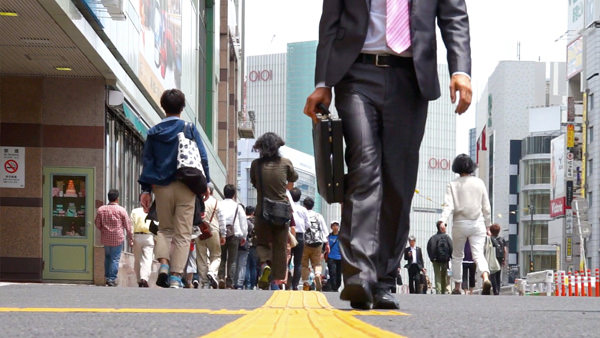
Mishap (Tokyo 2014), video still: Saeko Ehara
In Mishap, as the papers spill out of the briefcase onto the pavement, it presents a challenge to passersby to interact. It creates a 'secousse' or 'jolt' (Mouffe 2005, Bishop 2012) in their experience, or what Barthes (1981) refers to as 'punctum'-something that pricks, bruises or disturbs and changes the reading. The jolt is a momentary disruption to a familiar routine that provokes questions such as 'should I get involved?'. The reactions differed from site to site. In the circumstances it is unlikely that passersby would have recognised the intervention as an artwork. In Shanghai and Tokyo, they rushed to pick up my papers. In Bloemfontein, they offered condolences as they watched me gather my things. While in New Delhi, I was left to clean up my own mess. I found it difficult to assess the various responses in such a brief encounter. Generally, when passersby engaged, it appeared to reveal politeness, kindness, empathy and concern. When a passersby did not help it begged the question of whether it was my business suit and its associations with power, the way pedestrians are conditioned to disengage in public space, the fear of corruption, or apathy that prevented people from helping.
While I have not collated the anecdotes that were told afterwards, when passersbys stopped to ask questions it provided insight into their thoughts and feelings. In Tokyo, a passerby asked if I was performing a social experiment to measure levels of human kindness. In Shanghai, a passerby said he wanted to help pick up the papers, but he was reluctant to interfere with my 'confidential' documents. In Bloemfontein, a passerby claimed that if there had been money in the briefcase, people would be more inclined to help. Another passerby who witnessed the paper spill twice said he felt he was being made fun of. Although the cameras were mostly hidden from view, they also played a role and changed the conditions. Passersbys who were curious about the production process stopped to watch the videographer at work, and several who recognised the performance as slapstick joined in. One passerby wanted to be paid for appearing in the video.
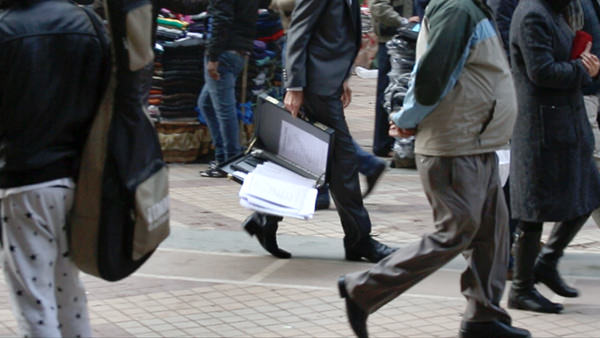
Mishap (New Delhi 2015), video still: Lights on Films
Psychologists may look to the bystander effect--the social phenomenon where individuals are less inclined to help when others are present-to explain the reactions. Social and situational factors (such as race, class, the amount and type of help required) can influence helping behaviour, rather than the type of people (Piliavin, Rodin and Piliavin 1969). The reactions could also be understood through a 'blasé outlook' experienced in the city consisting in the 'blunting of discrimination'--an unresponsiveness to stimulation, and a refusal or inability to be emotionally moved by, or involved in people and things (Simmel cited in Wolff 1950). Instead of a psycho-analytical approach, Mishap focuses on interactions with passersby to generate an understanding of human behaviour in public places. Random encounters on the street are often transitory and may not be worth a significant investment of time or emotion. In animating predicable and unpredictable scenarios, Mishap reveals how a balance of conviviality and disruption is needed to interrupt sites and situations. Mishap does not allow a space for deep connections or immediate discussion. Participants are left to ponder, question and reflect on their own reactions. This approach of close-distance (working with a site and unsettling its conventions) provides participants with an experience that may prompt ongoing conversations around the social relations and politics that govern site.
By activating audience participation, Mishap seeks to connect with what Jacques Rancière refers to in The Emancipated Spectator (2011) as an 'unpredictable subject'. Rancière opposes the segregation of art and theatre--both sites and roles--and advocates a two-way interaction between artist and audience that can create interplay between art and life. He argues that art has the ability to break down real social and political hierarchies--therefore the artist can activate audiences rendered passive by spectacles of the art world and commerce. For Rancière, human beings contemplate in the spectacle the activity that they have been robbed of (ibid.). Through exchange, the spectacle that is designed to separate activity from passivity can be interrupted.
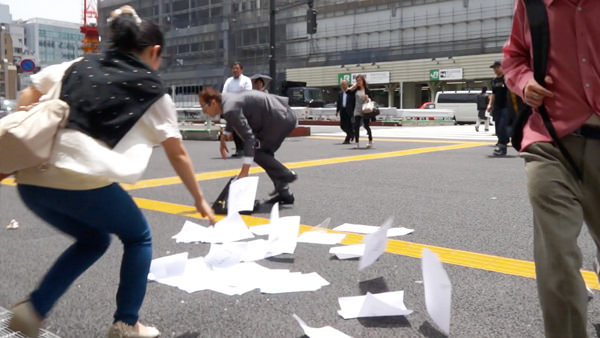
Mishap (Tokyo 2014), video still: Saeko Ehara
Disrupting the distance between artist and audience was essential to theatre directors Bertolt Brecht and Augusto Boal (1990). Brecht's method of Epic theatre was enlivened with a social function--the theatre was not a place of entertainment, but a forum for political ideas stirring reactions from audiences. Methods devised by Boal aimed to make spectators conscious of social situations, and therefore free themselves from at least their first oppression: that of being spectators (Boal 1990; Rancière 2011). Boal's techniques were designed to help the oppressed, raise consciousness and empower the working class. His subsequent innovation, The Theatre of the Oppressed (1998) fundamentally aimed to transform 'spect-actors' into protagonists who rehearsed alternative actions that they could carry out in real life. It was designed as practical training in social resistance, or a rehearsal for a revolution where spectators would not be aware they were taking part in a performance.
Boal's theatre often took place covertly in sites such as restaurants and supermarkets. In one example, actors seated at different tables in a restaurant engaged in a dispute with a waiter about paying a bill. The main actor, who had no money, offered to pay for his meal by taking out the rubbish or doing the washing up. One by one the actors draw other diners into a lively debate about the value of labour. Eventually someone collects money to pay for the bill, which offends some people and causes more disturbance. By transforming the restaurant into a public forum, the performance operates by stealth, unannounced to audiences as an artwork. Like Mishap, it turns the audience into 'active agents' (Bishop 2012) or performers and relies on their participation for the work to unfold (Ibid.). Boal argues that within Invisible theatre the public act freely as if they are in a real situation. By liberating theatrical energy, the impact of free theatre can be powerful and long lasting (Boal 1998). By empowering the marginalised and oppressed, Boal sought to give them the means to find their own solutions to social and personal problems. For Boal, theatre functions as a rehearsal for social action that can lead to real political change. It can run parallel to socially engaged art practices that are embedded in communities and that seek deep connections over long periods of time (Kester 2011). These live forums that recognise myriad conflicts bubbling under the surface foster the agonistic spaces Chantal Mouffe (2005) argues are necessary elements in a true democracy. They embrace conflict as a crucial part of a healthy, fully functioning democratic society.
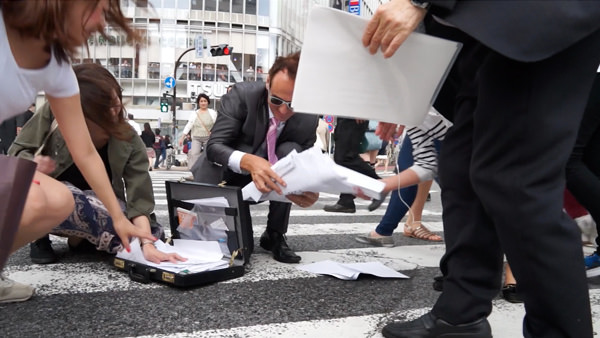
Mishap (Tokyo 2014), video still: Saeko Ehara
Informed by Boal's concept of Invisible theatre, the live iteration of Mishap relies on spontaneous responses. It is not announced to its audience nor revealed as an artwork. It is a strategic desertion from one-way performance, complete fiction and entertainment. Yet it maintains a distance from its audience and does not give participants a 'voice'. It appears to be anti-social because it purposefully cancels out opportunities for dialogue and reflexivity. Yet it 'cares for the situation' (Linder 2016) by making relations in the city visible. On some occasions, Mishap animated kindness and trust, and at other times it revealed hesitation and unease. In Bloemfontein, the project formed part of a public art program designed to enliven neglected public places in the city centre, and help facilitate a cross-city engagement with people from different parts of the community. The impromptu nature of the performance was not always welcomed by a passersby; a reticence to engage revealed complex social issues.
Artists are often implicated in the rapid gentrification of urban spaces worldwide. The social turn in art coincides with models of urban renewal. Spatial production and cultural production inform one another and play key roles in the growth of a city. Through co-option, absorption or resistance, artists are entwined in battles that reveal the redistribution, privatisation and regulation of public space. These battles reveal complex contests for power over infrastructure and communities (Thompson 2015). In Georg Simmel's analysis of the effect of urbanisation on the individual in The Metropolis and Mental Life (1903), he suggests urbanisation creates an ambiguous space that undergoes permanent shifts and changes that transform the mind. The effects are not necessarily negative and the 'blasé attitude' is one way city dwellers cope with rapid, contrasting stimulation. Through projects, residencies, and commissions that are designed to transform urban spaces, artists have the means to encourage reflection on these shifts and patterns. While the live iteration of Mishap makes relations visible on the street, the reflexivity it denies is possible through the video documentation. It undoes the fictional construction, enabling an analysis of the action and reactions in the street as they are re-played on a loop in the gallery.
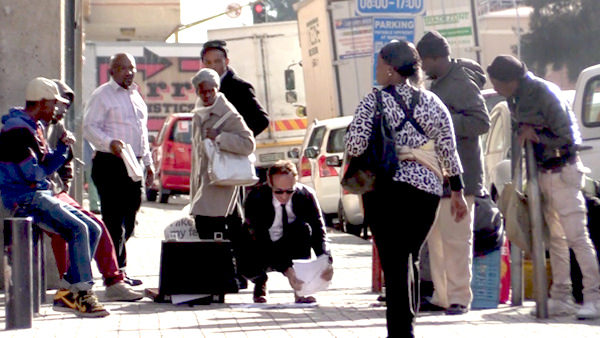
Mishap (Bloemfontein 2017), video still: Elysium Productions
By performing creative disruption in regulated urban sites, the artist can investigate ways to engage audiences in a critique of social space. Fiction and humour can be combined with surprise to disrupt the social patterns of commercial sites. Interstices within conventionally uneven and/or hierarchical social spaces can be created to produce a levelling effect or reveal disjuncture. As the sole performer in these spaces, the artist can be easily subsumed and unheeded. Critique may disappear, but it is not necessarily lost. The artist can adopt impromptu approaches that temporarily disrupt and invert social patterns, rather than succumb to commercial activity, social works or entertainment. A position of close-distance can allow the intent of the artwork to remain intact.
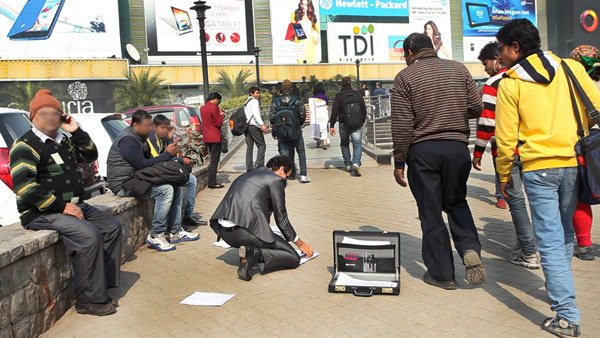
Mishap (Delhi 2015), video still: Lights on Films
Works cited
Barthes, Roland. Camera Lucida. Farrar, Straus and Giroux, 1981.
Bishop, Claire. Artificial Hells. Verso, 2012.
--- “Black Box, White Cube, Public Space.” Out of Body, Spring, 2016.
Boal, Augusto, and Susana Epstein. “Invisible Theatre: Liege, Belgium 1978.” The Drama Review, vol. 34, no. 3, 1990.
Boal, Augusto. Theatre of the Oppressed. Pluto, 1998.
Dasgupta, Romit. Re-reading the Salaryman in Japan: Crafting Masculinities. Routledge, 2012.
Doherty, Claire. Contemporary Art: From Studio to Situation. Black Dog Publishing, 2004.
Kester, Grant H. The One and the Many: Contemporary Collaborative Art in a Global Context. Duke University Press, 2011.
Kwon, Miwon. One Place After Another. MIT Press, 2004.
Linder, Adam. “Performers Speak about Performance: Adam Linder.” Out of Body, Spring, 2016.
Mouffe, Chantal. On the Political. Routledge, 2005.
Performa13, “Akademia Ruchu - The Market of Toys.” Performa13, 30 Jul. 2017, Web.
Piliavin, Irving M., et al. “Good Samaritanism: An underground phenomenon?” Journal of Personality and Social Psychology, vol. 13, no. 4, 1969.
Rancière, Jacques. The Emancipated Spectator. Verso, 2011.
Simmel, Georg. “The Metropolis and Mental Life.” The Blackwell City Reader, edited by Gary Bridge and Sophie Watson, Wiley-Blackwell, 2002.
Tati, Jacques, director. Play Time. 1967. Performances by Jacques Tati, Barbara Dennek and Rita Maiden. Madman Entertainment, 2004.
Thompson, Nato. Seeing Power: Art and Activism in the 21st Century. Melville House Publishing, 2015.
Wolff, Kurt H., editor, The Sociology of Georg Simmel. Free Press, 1950.

